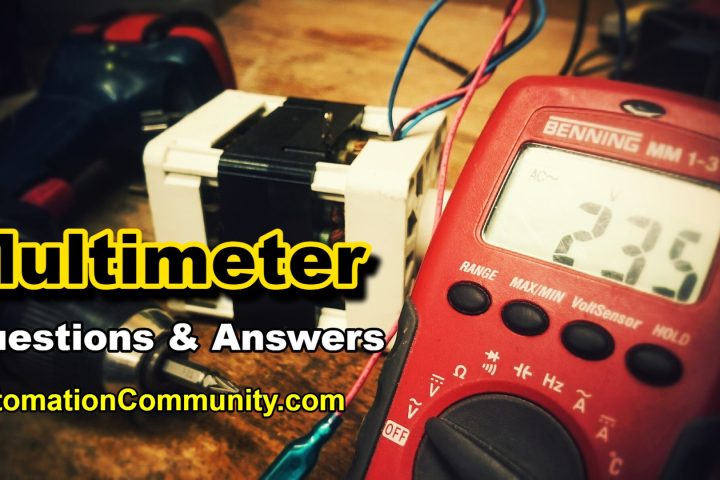Instrument Technician Tools
In this article, we provided a list of tools used by instrument technician tools with explanations for each tool.
Instrument Technician Tools

Multimeter
A multimeter is an essential tool for any instrument technician. It’s a handheld device that can measure electrical properties such as voltage, current, and resistance. Some models can also measure capacitance, frequency, and temperature.
A multimeter is versatile and can be used to troubleshoot and diagnose electrical problems in a wide range of equipment and systems.
Loop Calibrator
A loop calibrator is another crucial tool for instrument technicians. It’s used to test and calibrate sensors and transmitters. A loop calibrator can generate and measure electrical signals, simulate input signals, and provide a stable power source for field devices.
A loop calibrator is also capable of detecting faults and verifying loop continuity, making it an indispensable tool for maintaining accurate measurements and ensuring the proper functioning of instrumentation systems.
Clamp Meter
A clamp meter is a tool used to measure electrical current without having to break a circuit. It works by clamping around a wire and detecting the magnetic field generated by the current flowing through the wire.
Clamp meters can measure both AC and DC currents, making them useful for a wide range of applications. They’re commonly used in electrical maintenance, HVAC systems, and industrial troubleshooting.
HART Communicator
A HART communicator is a tool used to communicate with and configure field devices in a process control system. It uses the HART protocol to exchange data and commands with instruments such as transmitters, valves, and controllers.
HART communicators are commonly used in industrial settings to monitor and control process variables such as pressure, flow, and temperature.
Temperature Calibrator
A temperature calibrator is a tool used to measure and calibrate temperature sensors and other instruments. Temperature calibrators can be used to simulate and measure a wide range of temperatures, allowing technicians to test and verify the accuracy of temperature sensors and controllers.
Temperature calibrators are commonly used in industries such as pharmaceuticals, food and beverage, and petrochemicals.
Process Calibrator
A process calibrator is a tool used to measure and calibrate process instruments such as transmitters, controllers, and recorders.
Process calibrators can be used to simulate process variables such as pressure, temperature, and flow, allowing technicians to test and calibrate instruments in a controlled environment.
Insulation Tester
An insulation tester, also known as a “megger,” is a tool used to measure the resistance of electrical insulation in cables, motors, and other equipment. Insulation testers can be used to detect insulation problems such as breaks, cracks, and moisture damage, preventing equipment failure and safety hazards.
Insulation testers are commonly used in industries such as electrical utilities, building maintenance, and aerospace engineering.
Continuity Tester
A continuity tester is a tool used to test the electrical continuity of wires and circuits. Continuity testers can be used to detect open and short circuits, identify wiring errors, and troubleshoot electrical systems.
Continuity testers are commonly used in industries such as electronics, automotive, and building construction.
Wire Strippers and Cutters
Wire strippers and cutters are tools used to cut and strip wires and cables. They can be used to remove insulation, cut wires to length, and make connections between wires and terminals.
Wire strippers and cutters are commonly used in industries such as electrical wiring, telecommunications, and home repair.
Pressure Gauge Calibration Kit
A pressure gauge calibration kit is a collection of tools used to calibrate and test pressure gauges, which are used to measure pressure in pipes, vessels, and other process equipment.
A pressure gauge calibration kit includes a pump, a reference pressure gauge, and various adapters and hoses for connecting to different types of gauges.
Infrared Thermometer
An infrared thermometer is a non-contact temperature measurement tool that uses infrared radiation to measure the temperature of an object or surface. Infrared thermometers can measure the temperature of objects that are difficult or dangerous to access, such as high-voltage electrical equipment or moving machinery.
Infrared thermometers are also used in food processing, HVAC systems, and medical applications.
Oscilloscope
An oscilloscope is a tool that measures and displays electronic signals. An oscilloscope can be used to troubleshoot and diagnose problems in electronic circuits, such as glitches, noise, and timing issues.
An oscilloscope can display waveforms in real-time, making it easy to identify abnormalities and correct them quickly.
Digital Thermometer
A digital thermometer is a tool used to measure temperature with high accuracy. Digital thermometers consist of a probe or sensor that can be inserted into a liquid or material to measure its temperature.
Digital thermometers are commonly used in laboratory and manufacturing settings, as well as in HVAC systems and food safety inspections.
Megohmmeter
A megohmmeter, also known as a “megger,” is a tool used to measure the resistance of electrical insulation. It applies a high voltage to the insulation and measures the current flowing through it.
Megohmmeters can detect issues with insulation, such as cracks or moisture, that could lead to equipment failures or safety hazards.
Gas Detector
A gas detector is a tool used to detect the presence of hazardous gases in the air. Gas detectors are commonly used in industrial settings where workers may be exposed to gases such as carbon monoxide, methane, or hydrogen sulfide.
Gas detectors can help prevent accidents and protect workers from exposure to harmful gases.
Level Gauge
A level gauge is a tool used to measure the level of liquids in tanks or vessels. Level gauges are used in industries such as oil and gas, chemical processing, and water treatment.
Level gauges can help operators maintain consistent levels in tanks, which can help prevent spills, leaks, and other hazards.
Pneumatic Calibrator
A pneumatic calibrator is a tool used to test and calibrate pneumatic instrumentation systems. Pneumatic calibrators can generate precise pressure and vacuum signals, as well as measure pressure, flow, and temperature.
Pneumatic calibrators are commonly used in industrial settings, such as refineries and power plants, to ensure accurate and reliable measurements.
Pipe Bender
A pipe bender is a tool used to bend metal pipes to a specific angle or radius. Pipe benders are commonly used in plumbing and HVAC applications, as well as in industrial settings.
Pipe benders can help technicians create precise bends in pipes, which can help ensure that they fit properly and function as intended.
Megger Tester
A megger tester, also known as a “megohmmeter,” is a tool used to test the insulation resistance of electrical systems. Megger testers apply a high voltage to the system and measure the resulting current flow.
Megger testers are commonly used in industrial and commercial settings, as well as in residential settings for electrical maintenance and repair.
Signal Generator
A signal generator is a tool used to generate electronic signals of various types and frequencies. Signal generators can be used to test and troubleshoot electronic devices, as well as to simulate real-world conditions for testing purposes.
Signal generators are commonly used in industrial and commercial settings, as well as in research and development applications.
Megasonic Cleaner
A megasonic cleaner is a tool used to clean and remove contaminants from sensitive equipment and components. Megasonic cleaners use high-frequency sound waves to create microscopic bubbles that can penetrate small crevices and remove dirt, grease, and other particles.
Megasonic cleaners are commonly used in industries such as semiconductor manufacturing, medical device production, and aerospace engineering.
Spectrum Analyzer
A spectrum analyzer is a tool used to analyze and display electronic signals in the frequency domain. Spectrum analyzers can be used to identify and diagnose problems in electronic systems, as well as to test and optimize performance.
Spectrum analyzers are commonly used in industries such as telecommunications, broadcasting, and audio engineering.
Data Logger
A data logger is a tool used to record and store data from sensors and other instruments over time. Data loggers can be used to monitor and analyze environmental conditions, as well as to track performance and diagnose problems in complex systems.
Data loggers are commonly used in industries such as agriculture, environmental science, and energy management.
Cable Tester
A cable tester is a tool used to test and diagnose problems in cables and wiring. Cable testers can be used to check for continuity, identify shorts and open circuits, and test for proper wiring connections.
Cable testers are commonly used in industries such as telecommunications, audio and video production, and computer networking.
Torque Wrench
A torque wrench is a tool used to tighten bolts and other fasteners to a specific torque value. Torque wrenches can be used to ensure that fasteners are tightened to the correct specification, preventing damage or failure of critical components.
Torque wrenches are commonly used in industries such as automotive, aerospace, and heavy equipment maintenance.
Pressure Gauge
A pressure gauge is a tool that measures pressure in various industrial applications. Pressure gauges consist of a dial, a spring, and a sensor element that responds to changes in pressure.
Pressure gauges are commonly used in the oil and gas industry, chemical processing plants, and water treatment facilities. Pressure gauges can help identify issues with equipment, such as leaks or blockages, that could compromise safety or cause system failures.
Conclusion
These are just a few examples of the tools that an instrument technician might use. Each tool serves a specific purpose and can help technicians diagnose and repair complex systems in a safe and efficient manner.
Missed any instrumentation tools? Share with us through the below comments.
Read Next:















Comments
2
Thank you.
Well and good information